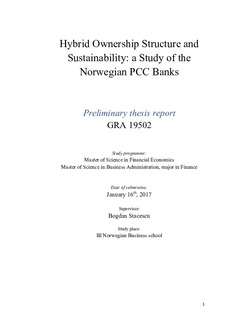| dc.contributor.author | Petrova, Anelia Evgenieva | |
| dc.contributor.author | Gauslaa, Milena Nedelkova | |
| dc.date.accessioned | 2018-02-22T12:25:15Z | |
| dc.date.available | 2018-02-22T12:25:15Z | |
| dc.date.issued | 2017 | |
| dc.identifier.uri | http://hdl.handle.net/11250/2486456 | |
| dc.description | Masteroppgave(MSc) in Master of Science in Finance - Handelshøyskolen BI, 2017, Masteroppgave(MSc) in Master of Science in Business, Finance - Handelshøyskolen BI, 2017 | nb_NO |
| dc.description.abstract | Until 29 years ago, all Norwegian banks were either commercial or saving banks.
Since that time, we have witnessed changes in the institutional context of the
banking industry which resulted in the emergence of a new hybrid ownership model
– a PCC bank. The consolidation and deregulation of the banking sector in Norway
at the beginning of 21st century enabled a new channel of becoming a PCC –
through a merger. This paper explores the motivation behind these corporate
restructuring decisions and their implications based on the results from a hand-made
data sample. We conclude that the size of the bank determines the employed
strategy. Larger banks are more oriented towards inorganic growth, i.e. issuing
equity or getting involved in a merger activity. Smaller banks, on the other hand,
exploit the competitive advantage of their local identity. | nb_NO |
| dc.language.iso | eng | nb_NO |
| dc.publisher | BI Norwegian Business School | nb_NO |
| dc.subject | finans | nb_NO |
| dc.subject | finance | nb_NO |
| dc.subject | financial economics | nb_NO |
| dc.title | Hybrid ownership structure and sustainability: a study of the Norwegian saving banks | nb_NO |
| dc.type | Master thesis | nb_NO |

